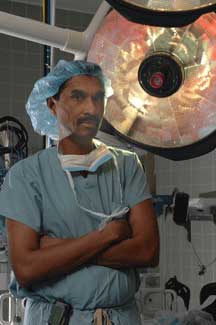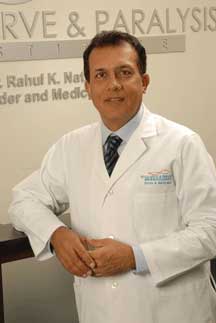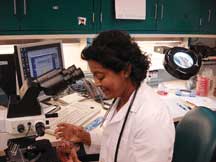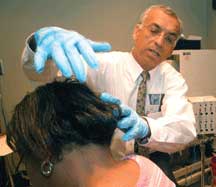Life
The Top Indian Doctors In America

These physicians are best of the best in the profession.
|
It’s like bringing them back from the dead. The patient had already undergone seven heart surgeries and this was to be his eighth. When he came to Dr. Valluvan Jeevanandam at the University of Chicago Hospital, he had been turned away by several other hospitals as too risky a case: being a Jehovah’s Witness, the patient would not, could not, take a blood transfusion during surgery and that made the case doubly challenging. “It is a high wire act, because not only are you doing a reoperation, but you’re doing it where you can’t give any blood. So you are stretching the limits of what is deemed to be possible,” says Jeevanandam, who is a heart failure specialist. “The most challenging cases are the ones where patients have already had several operations and we have to chip out the heart. We call it cardiac archaeology – finding the structure to the heart during surgery.”
Every week he operates on four to five such hopeless cases that no other physician wants to touch – from a patient who refuses blood transfusions because of religious convictions to someone who’s 85 years of age and has already received three valves, a bypass and needs a re-operation. Says Jeevanandam, “A lot of our patients had already been written off and been referred to a hospice and we take them on and they actually do very, very well.” Jeevanandam is one of nearly 100 Indian American physicians listed in Castle Connolly’s America’s Top Doctors, a leading source for the most eminent medical specialists across the United States in 25 specialties and 90 subspecialties identified by The American Board of Medical Specialties. The 2007 edition lists nearly 5,000 doctors from among 650,000 practicing physicians nationwide, the top 1 percent. The nearly 30,000 Indian American physicians constitute nearly 5 percent of the profession, so the 2 percent of the Indian physicians are significantly underrepresented on the list. Jeevanandam, who hails from Curin in Tamil Nadu, is an acknowledged rainmaker for the hospitals, driving up volume with difficult cases that other hospitals often pass on. After his fellowship at Columbia Presbyterian Medical Center, he went to work at Temple University Hospital in Philadelphia just as the whole transplant program moved to a competing hospital. He was thinking of leaving when he was made director of a new heart transplant program. He recalls, “So we started doing transplants then and a lot of it was learning in the line of fire, because we didn’t have a cardiologist, there was no infrastructure. I was the infrastructure for about two years.” Jeevanandam mastered the complete management of a transplant station, creating the program from scratch, going from zero cases to 54, surpassing the 30 cases the hospital had done the previous year. He recalls, “Everybody was kind of shocked, including myself, because I didn’t think we’d be that successful.” In fact, Temple, although a relatively small hospital, hit the ranks of the top four hospitals nationwide for heart transplants and even led the rankings a few times. He performed over 100 transplants a year there. Since not every case was suitable for transplants, Jeevanandam came up with creative restructuring and the whole area of operating on inoperable cases became his speciality. At the University of Chicago Hospitals, where he is professor of surgery and chief of Thoracic and Cardiac Surgery, he performs over 30 transplants a year and 250 heart repair surgeries a year. As he told Business Week, “Think of us as Ellis Island – send us the patients you don’t want to operate on, the difficult cases, the complicated patient, give us your worst. We’ll take care of them!”
Jeevanandam uses many different techniques from transplants to restructuring. The innovations include newer drugs and techniques like micro bypass circuitry and the implant of CardioVad, an experimental ventricular assist device, which pumps blood more efficiently to take pressure off a weak heart. “The big advantage of the CardioVad is that you can turn it on and off,” says Jeevanandam. “It gives patients a great psychological boost because they feel they are in control and we are the only site in the entire world doing it. It’s kind of my baby, from taking it from a very early stage and hopefully getting it in a year to general clinical practice.” From the hospice we move to the delivery room. At the Texas Nerve & Paralysis Institute in Houston, Tex., Dr. Rahul Kumar Nath, who is founder and director, often deals with patients only a few days old who suffer a particular kind of nerve injury at birth, which affects the growth and function of the arm and hand. Not all the nerves may be as severely injured as others, so half the arm might grow quite normally and the other half may not. This brings about imbalances and abnormalities, known as twisting deformities at the bone. Similar injuries can also occur in adults who are involved in road accidents. Brachial Plexus Palsy is a rare injury affecting 3 in 1,000 U.S. births, giving rise to nearly 15,000 such births annually. A similar numbers of adults are affected from injuries every year and often it’s difficult to get help locally. The most common of the injury is Erb’s Palsy, paralysis affecting the shoulder and arm. Normally these injuries are addressed with nerve grafting, but Nath has developed new nerve transfers, and for children specifically he’s developed special surgeries for the muscle and bone deformities. Traditional surgeries take 8 to 9 hours to perform but Nath has fine-tuned the process to just over an hour. Recently he had a 4-year-old patient whose arm was paralyzed after a fall from a motor scooter. She had seen four different physicians before being referred to him. After the one and a half hour operation, Nath had her arm moving again in a few months. Nath, who was with the Texas Children’s Hospital for many years, is chairman of the International Society for Brachial Plexus and Peripheral Nerve Injury and also founder and co-editor of the only journal addressing this issue. He’s also the only surgeon in the U.S. who’s developed a special surgery for Foot Drop, an injury to nerves in the foot. His research has led to the creation of equipment and techniques for difficult nerve repair, which have been patented by him. Currently he’s working on developing artificial DNA in the lab to block scar production in wounds, surgical areas and nerves and ultimately in the skin as well. “It’s a fascinating field. Earlier people had thought that paralysis could not be cured, but it’s absolutely the opposite,” he says. “It’s an absolute revolution in that particular field. The key thing though is that patients have to be evaluated by a specialist within 3-6 months of the onset to get the best results, so there is a time limitation.”
Nath has treated over 5,000 patients in the U.S. as well as from 26 countries, and has made the Top Doctors list consistently for the past seven years. Since he is licensed to practice in 16 states, he conducts satellite clinics in several cities, and also trains physicians from developing countries in these techniques. Asked about the most gratifying part of his work is, he says, “Every day you see babies, and grownups too, who could not move, move – and what can be better than that? It’s great to see children, an hour after the operation, being able to lift their arm over the head or to be able to feed themselves.” The super bug MRSA, a dangerous bacterium, has become the new four-letter word around hospitals and is responsible for many complications in patients recovering from surgery. Infectious disease specialist Dr. Nalini Rao of UPMC Presbyterian Shadyside Hospital in Pittsburgh is an acknowledged expert. Rao, who is clinical professor of medicine and orthopedics at the University of Pittsburgh School of Medicine, led the western Pennsylvania area initiatives to control MRSA in the hospitals and authored “Preoperative Eradication of STAPH,” a seminal paper in the field. “In the hospital you can pick up infections when you’re going in to get better,” she says. “The patient is at high risk to get MRSA, colitis and other illnesses so now the state has mandated that all the hospitals have to put together a preventive program. We have created several initiatives in the Pittsburgh area to prevent blood, urinary tract and other infections.” Rao, who is the chief of the Division of Infectious Disease and director of Infectious Control Program, has a large private practice and also conducts research and clinical trials on bone and joint infections. “The nice part of my profession is the gratification I receive because of my patients,” she says. “I am indeed a patient advocate and when the outcome is favorable it literally makes my day.” Within Infectious Disease, she specializes in hospital related infections and travel medicine, a sub-specialty in which she counsels people going overseas on health hazards and infections. In Pittsburgh, she directs the only international travel health center, which offers counseling, immunizations and health certificates, The other part of her complex specialty is bone and joint infection. In the U.S., close to half a million people undergo implants for the joints, due to accidents, and when screws and plates have to be attached to the extremities, there is a risk for infections. Rao is one of only a few specialists in the country with an expertise in muscular skeletal infections. Rao has made Top Doctors in America listing every year in the past seven years and travels around the country to give lectures on bone and joint infections. One of her most satisfying cases has been of a patient who had an MRSA infection of a total knee replacement on two occasions. He had many risk factors, including his heavy weight, and was told that he could not get a new knee put in, and the upper and lower portions of his leg had to be fused with a rod. “This was extremely painful as the rod almost hit the hip joint. He could not drive and felt very crippled, was very depressed and had gained a lot more weight,” says Rao. “He came to me and said I need to get something done about this, otherwise I’d rather just die.”
She treated the MRSA infection and he was able to get a third knee replacement. After rehab, he remained free of the infection and was able to get a gastric bypass surgery and lost over 100 pounds. Recalls Rao, “He came to see me and I couldn’t recognize him! He can now bend his knee to a full motion, like normal people. I did a total physical on him – he looks healthy and he’s lost his weight. He’s able to drive and wants to get back to work. He’s like a new man!” From complex infections many of us might hear about only in medical journals we move to ailments almost all of us suffer at one time or another and which often sideline us from daily activity – chronic back pains and headaches. After some time, even families tend to lose patience and compassion for these daily sufferers, but Dr. Subhash Jain, who runs the Centers for Pain Management in New York and New Jersey, takes it all very seriously for his belief is “Every patient is the only patient.” Besides being acknowledged in the Top Doctors of America, Jain has been recognized for eight consecutive years by New York magazine as one of the best doctors in the city. For 22 years he was an attending physician at Memorial Sloan-Kettering Cancer Center, where he was founding chief of the Department of Anesthiology’s Pain Service and director of the hospital’s fellowship program. He was also Chairman of Hackensack University Medical Center’s Department of Pain and Palliative Care. Almost four in five people suffer some back pain. Most of the time it is just an irritant, but sometimes it can be deadly serious. Jain recalls a 28-year-old man who suffered from constant back pain and had found no relief from either over the counter medication or pre scri ption pain-killers. Jain’s examination and tests revealed that he had a pancreatic tumor. He employs state-of-the art techniques to manage and treat acute, chronic and cancer pain, including pharmacological, psychological, neuroblative, and neural blockage. “My personal philosophy is that I focus on the cause and how to eliminate the cause. For example, a lot of smokers smoke and cough and their posture changes. There’s a direct co-relation between smoking and back pain. I focus on their day-to-day life.” Jain rose through the ranks to become chief of Pain Service and director of the Pain Program at Memorial Sloan-Kettering, where he remains a consultant in pain management. A clinician, researcher, and teacher in pain management, he has lectured internationally and written extensively on the subject. While he treats all aspects of pain, his research expertise has been in back, pelvic, reflex-sympathetic dystrophy and cancer pain. He is consulting with the Ministry of Health in India to develop a new curriculum for physicians and nurses in pain management and introducing a sub-specialty certification for pain management in India. Asked about his work philosophy, he says, “Every human deserves to be without pain. The quality of life of a person should be brought to the level where they can function as a human being.” Parkinson’s disease can be devastating, especially when it hits you when you’re only 33 years old. In 1985, when Dr. Kapil Sethi was himself just 32, he had a patient about his age, not unlike the actor Michael J. Fox who developed Parkinson’s disease at 28. Sethi recalls, “I had to tell her and slowly broke the news to her. It was quite a shock. She had two little kids and thought that was the end. She and her husband were totally scared. Luckily they stuck together and we went through it together.” Over the following 22 years, the patient went through several surgeries, participated in research and underwent different treatments, but is still functional. Life went on for her and she gave birth to two more children. One child is in college and another is now getting married. Says Sethi, “They are still with me. We are facing new problems everyday, but she’s there. The other day we had a Parkinson’s walkathon– she was leading it. She’s still around.” Sethi, a neurologist and a professor of neurology at the Medical College of Georgia in Augusta, Ga., heads the Movement Disorders Clinic and also researches and educates residents and medical students. His medical focus is in movement disorders, such as Parkinson’s disease, essential tremors, Restless Leg Syndrome, so his connection with patients is often life-long. He is one of the pioneers in the study of this disease in Georgia. “Parkinson’s disease is an immune degenerative disease and is slowly progressive. We don’t know what causes it and we don’t know exactly how to slow it down,” he says. “It’s a very frustrating disease simply because patients get worse eventually and till we know what causes it, it will be difficult to find ways to slow it down. Whatever little progress we make is very gratifying not only to the patient but to the person who is treating him or doing the research. Even small baby steps are important, because right now we have no way to slow it down.” One attempt is to study Creatine, a supplement used by athletes to boost energy levels and build muscle, which may slow the progression of neurological and neuromucular diseases, such as Lou Gehrig’s and Parkinson’s disease. According to Sethi, mitochondria, the powerhouse for cells, become dysfunctional in the brain, muscle, and platelet cells of many patients with Parkinson’s disease and this dysfunction is visible in postmortem brain studies and in muscle biopsies and measures of platelet activity in the living. “By giving more energy to the cell, you are giving them a safety margin,” says Sethi says. “If a cell is dying, it takes another route and that would be surviving.” He notes that Creatine has virtually no side effects and helps build muscle and could well slow the progression of Parkinson’s disease. Sethi is the local investigator for the national investigations being conducted by the National Institute of Health through the Parkinson Study Group. Sethi is also active in the India Alliance, a nonprofit organization, which has set up a network of leading academic Parkinson disease doctors in India and the US to foster research and pharmaceutical trials. What does he think is the most satisfying part of his work? “I think it’s my contact with my patients and their families over the years and the fact that I’m with them from the beginning to the end. Parkinson’s is a chronic disease, not like taking somebody’s appendix out. It’s an over 20 year relationship.” So is that what it’s all about – helping your patients get a better quality of life and walking them through the tough times? “Exactly,” says Sethi. For the patients in the care of Dr. Naynesh R. Kamani at Children’s National Medical Center in Washington D.C., it’s literally a matter of life and death. “If the treatment we deliver works, then the patients are cured. If it doesn’t work, the patient dies. Every time we treat a child with a bone marrow or cord blood transplant, the outcome will determine whether the child will live or die.” Kamani is in charge of the blood and marrow transplant program and researches the use of umbilical cord blood as a source of adult stem cells for transplantation. “Bone marrow and umbilical cord blood are two different stem cell sources that we use for the purpose of transplantation in the cases of a large variety of malignant and nonmalignant childhood disorders,” he says. He performs transplants in 70 to 80 different pediatric diseases, including terminal cancers such as leukemia and lymphoma, brain tumors and inherited diseases of the blood and immune system. He has treated children with severe combined immune deficiency, commonly known as the Bubble Boy disease, a disease where children are born without a functioning immune system and in the absence of a transplant they die within the first six months or a year. Kamani is doing cutting edge research in using cord blood cells as a source of stem cells to correct inherited diseases of the blood, participating in national and local clinical trials: “A lot of innovations are being made because traditionally it’s not a disease that’s been treated with cord blood transplantation.” He recalls a family in which two siblings were affected since this is a genetically inherited disorder: first the girl received the cord blood transplant and five years after the transplant, she’s doing well. Subsequently, her brother too had the disease. Says Kamani, “He also got a cord blood transplant and he’s also doing fine, about two years after the transplant. So both kids are completely healthy, have no significant long term complications and are doing great.” And if they hadn’t received the treatment? He says, “They both would have died during infancy basically. This is a disease which kills during infancy if left untreated. The other alternative would have been bone marrow transplant but they didn’t have a sibling who could have donated marrow to them. They did not have a donor so they had no other option.” Kamani, a strong advocate of bone marrow donations, is on the board of the National Marrow Donor Program, which runs a 4 million strong registry of volunteer bone marrow donors all over the country. There is a shortage of minority donors, which can greatly hamper the task of finding compatible donors, since the chances of success are greater if the donor and patient are from the same racial or ethnic background. “One should always consider signing up because for most of these donors that will be the only opportunity they’ll ever have of saving someone’s life,” says Kamani. He is also assisting with the establishment of cord blood banks and bone marrow transplant programs in several cities in India. Dealing with children with fatal illnesses on a daily basis is difficult but he says he enjoys it because he loves kids and tries to interact with them and their parents on different levels. “The challenge is that our field is fraught with a lot of poor outcomes,” he says. “A number of our patients still don’t do well even after what we think is the best therapy available out there. So we deal with failure quite often and we’ve got to learn from our failures. But we also have to relish our successes because without these successes we wouldn’t be able to continue, we would get burnt out quite quickly.” Asked about the rewards of the job, Kamani says, “The rewards are really to see the children after they’ve been cured, seeing them graduating from high school or college, or getting married. As their physicians, we often become part of the families and those are the rewards we live with, when parents of children and the children themselves recognize you as someone who’s made a difference in their lives.” Indeed, for these physicians, the rewards are complex and intangible, much more than a passion for their work and go a lot deeper than status or a bank balance. It is a pact with the patients, which is sacred, and which is the main reason for the well-oiled, detailed machinery of the best medical care to be set in motion. Valluvan Jeevanandam, the heart failure specialist from Chicago University Hospital, sums it up succinctly: “I put everything into perspective. When someone tells me I’m a great doctor, I tell them, ‘Listen, if your house had a leak, you’d be extremely grateful that a plumber was there. So I’m a glorified plumber, electrician, carpenter all rolled into one. Everybody in the world has their own role in life and mine happens to be of the surgeon. But there are people in the operating room who are as important, and everything we do, we do as a team.”
|







